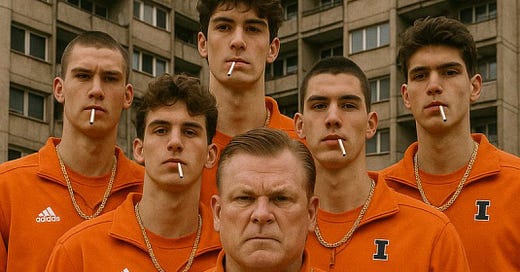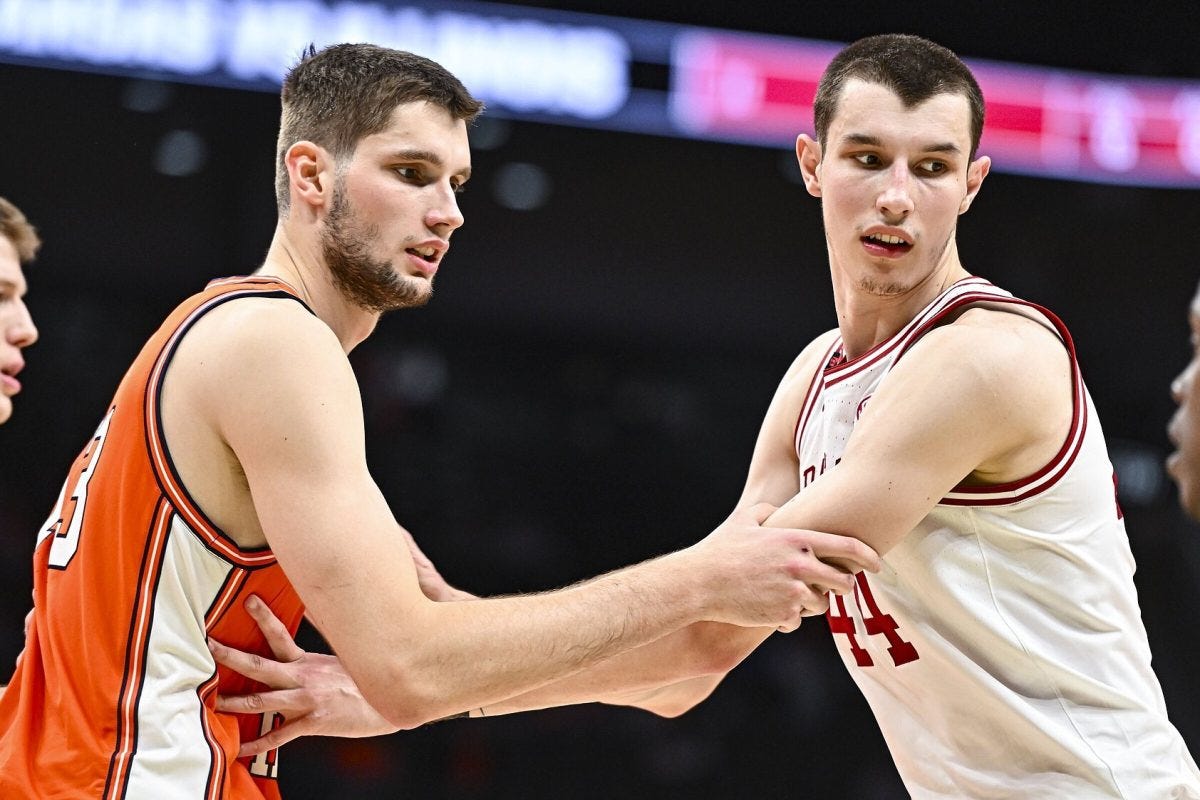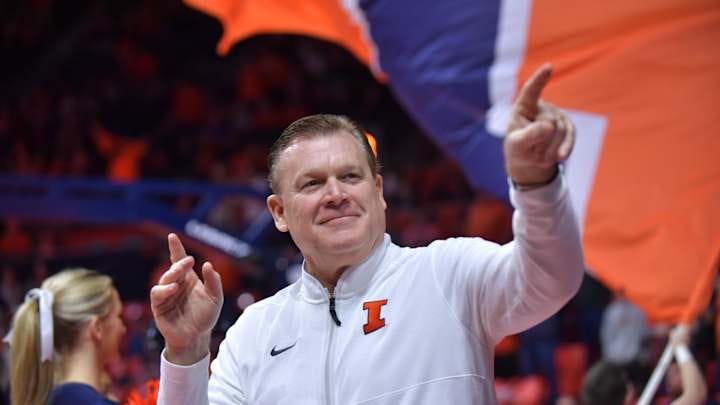Illinois basketball's Eastern European odyssey
Brad Underwood's program is stockpiling players whose names end in "ic". It could put the Fighting Illini at the forefront of the sport's next big trend
Over the past several years, it has become a time-honored tradition in college athletics, something that may have been unique once upon a time, but is now something more routine, if not forced and occasionally cringe-inducing.
Here’s how it usually goes:
A coach will hear from a recruit who informs them that they’re committing. The coach gets off the phone, ends the video chat or drops the note from the carrier pigeon and rushes to their phone. They get on social media and relay the same message they always do in such a situation, informing their eager, soon-to–be-excited fan base of their newest acquisition with a particular hashtag, gif or, for the adventurous, a custom-made video.
Late last month, Brad Underwood took a slightly different approach.
On April 28, news leaked that his Illinois basketball program had just secured a commitment from Andrej Stojakovic, a former McDonald’s All-American who was Cal’s leading scorer last season and one of the most coveted guards in the transfer portal. If his name looks familiar, yes, it’s because he’s Peja Stojakovic’s son.
Minutes after that, Underwood, like so many other coaches, logged onto social media and posted a picture to commemorate the occasion. Only instead of a hackneyed phrase only his team’s own fan base and a small sliver of college basketball sickos understand, Underwood instead posted a computer-generated picture of himself in an orange Nike tracksuit and a black flat cap while crouching in front of a Soviet-era Khrushchyovka apartment building, the kind of Brutalist monstrosities you see in the background of any gloomy Eastern European cityscape.
If there is a contest for the most self-aware coach in college basketball, Underwood may have clinched it with a simple decision to hit “Post” on a tweet.
Few, if any, teams in men’s college basketball have had an offseason like Underwood’s Fighting Illini, at least thus far. The addition of Stojakovic was far from an outlier. If anything, it only deepened what has become a norm – not because many of Illinois’ other incoming players for the 2025-26 season are the offspring of former NBA All-Stars (though that would be extremely cool), but because of his ethnic background.
Over the past year, the Illini have relied heavily – certainly more than any other major-conference program – on European talent, specifically players from Eastern Europe. Though Stojakovic was born in Greece and played high school ball in suburban Sacramento, he became the fourth player to commit to Illinois for its 2025 recruiting class who is of Balkan descent and whose last name ends in “ic.” That doesn’t even include managing to hold on to standout big man Tomislav Ivisic, who put off a potential run at the NBA Draft or a chance to be courted in the transfer portal.
Beyond Stojakovic, the Illini will be welcoming these players into its 2025 class:
Zvonimir Ivisic, Tomislav Ivisic’s 7-foot-2 twin brother who comes to Illinois after playing his first two college seasons for John Calipari, first at Kentucky and then last season at Arkansas, where he blossomed into a starter for a Sweet 16 team. He has an excellent shooting touch for a player his size, making 37.6% of his career 3-pointers, and is one of the best rim protectors in college basketball, with 1.9 blocks in 19.1 minutes per game last season. Before heading to the States, he played professionally from 2020-23 in the league that covers the countries that were once part of Yugoslavia. Both he and his brother are from Croatia.
Mihailo Petrovic, a 22-year-old point guard who most recently played for Mega Superbet in the Adriatic League, where he has emerged as one of the top MVP candidates this season. The 6-foot-3 Serbian is averaging 13.4 points and 7.3 assists this season. He’s been playing professional basketball since he was 16.
David Mirkovic, a 6-foot-9 forward who’s on the younger end of this group, at only 19 years old. Still, he has plenty of experience, having played the past two seasons for Adriatic League club SC Derby, the former home of both of the Ivisic brothers. This season, he’s averaging 8.6 points and 6.8 rebounds per game. Like Petrovic, he’s Serbian.
This Slavic influx didn’t just begin in 2025.
After the 2023-24 season, an Illinois team that lost all five of its starters from a squad that made it to the Elite Eight for the first time since 2005 reloaded with international talent, nabbing Tomislav Ivisic, wing Will Riley from Canada and, more notably, Kasparas Jakucionis, a 6-foot-6 Lithuanian guard who played for youth teams of European professional clubs before committing to Underwood in May 2024. Last season, Jakucionis led Illinois in points and assists per game, earned third-team all-Big Ten honors and now he and Riley are both projected as first-round picks in next month’s NBA Draft, all while helping the Illini spend the majority of what could have easily been a rebuilding season ranked in the top 25.
Over the past 12 months, going back to Jakucionis and Ivisic’s commitments last May, Illinois has brought in six Eastern European players.
It’s not occurring by chance, either. It’s a cogent and savvy strategy.
Underwood and his staff have prioritized European players when building their rosters in what’s become an increasingly transient and unpredictable sport. The Illinois coach told Kevin Sweeney of Sports Illustrated last summer that the Illini scout and recruit major European events the same way they would a prominent AAU showcase like the Peach Jam.
"Being a familiar face over there with the “I” and letting the people over there see us is vital in terms of comfort," Underwood said, according to Sweeney. "We have to keep sticking our nose over there and make it just like an event in Atlanta or Augusta or whatever it might be."
The key difference, of course, is that these aren’t raw, potentially volatile high-schoolers. These are hardened, older and generally tougher and more refined men with years of professional basketball under their belts in leagues whose reputations internationally are trumped only by the NBA. With the exception of the American-bred Stojakovic, each of those players came into the college game with some level of professional experience.
This isn’t exactly uncharted terrain for Underwood, either. The 61-year-old basketball lifer has long been a fan of the European game, with its emphasis on rapid ball movement, off-ball cuts and outside shooting, and has recruited European prospects going all the way back to his days as a junior-college coach in the 1980s.
Still, for someone who will be in his ninth season at Illinois in 2025-26, why have those efforts suddenly ramped up?
For one, Underwood and his assistants have spent years fortifying connections in the European game, none of whom have been more valuable than Miško Ražnatović, Nikola Jokic’s longtime agent and the representative for Petrovic, Mirkovic, and the Ivisic twins. Jakucionis’ rise to stardom last season only made Illinois that much more of an attractive destination for European players, particularly at a university where 24% of the student population is from outside of the United States.
Then there are the broader reforms in the world of college sports. Previously, top European prospects would have simply remained with their professional teams, continuing to make a good living and holding onto their dreams of jumping to the NBA, rather than be paid nothing to uproot their lives and play college basketball. Now, with the market for many power-conference starters at seven figures, American schools can not only be financially competitive with European clubs, but outbid them for some of their best players.
“You see it in the NBA now. The international piece is real,” Illinois assistant coach Geoff Alexander, the leader of the Illini’s European recruiting, said to 247Sports last fall. “It’s now the same with the college game.”
Illinois’ fanbase – one of the more passionate, engaged and terminally online in the sport – has embraced the endeavor. The picture Underwood tweeted after Stojakovic’s commitment came from an Illinois message board. Others have conjured photos of Underwood as a Soviet general. Some fans have come up with creative monikers, like “Bradislav Underwood” for their coach or the “Illinois Basket-Balkans” for their team.
For as uproarious as the memes and AI images are, they’re not entirely accurate. Illinois, like any college program, still mines the high school ranks for talent and gets players out of the portal whose family lineage can’t be traced back to the Eastern Bloc. As part of its rebuild last year, it got top-50 recruit Morez Johnson Jr. and five American-born transfers and even this year, it has two high schoolers, both of whom are in the top 150 of their class.
What Illinois has managed to do, though, is get ahead of what could be the next great, largely untapped source of talent in college basketball.
Modern college basketball history has been defined by coaches and programs who benefitted from embracing a segment of the player pool before others in the sport did. Jerry Tarkanian and others thrived with junior-college standouts who, for one reason or another, were overlooked. John Calipari lifted up Memphis and rapidly rebuilt Kentucky by relying overwhelmingly on star freshmen. Steve Fisher, at least for one particularly famous class, did the same at Michigan in the 1990s. Fred Hoiberg and Eric Musselman leaned heavily on transfers at a time when few others dared to. Eventually, others start to catch up, but there’s great value in recognizing a market inefficiency before anyone else.
Illinois isn’t the only school bringing in international players for next season, but nobody in a power conference is doing so to quite the extent of Underwood’s program.
What ends up coming from it could very well change the face – and the names – of college basketball.
My favorite things I read this week
Even two years into The Front Porch’s existence, I’m still getting acclimated to the newsletter format and am hoping to add more of a personal touch to all of this beyond just dumping 2,000-word stories into your inboxes.
I’m planning on ending newsletters now with some reading recommendations. If you enjoy my work, there’s at least a decent chance you’ll like some of the more interesting things I’ve come across in my internet travels in a given week. Plus, it’s a good way to highlight the excellent work other journalists are producing, both in the Substack network and beyond.
- at SID Sports examines the significance of Kentucky splitting its athletic department off from the university and turning it into an LLC
- at the aptly named Neil’s Substack breaks down which games matter most in a best-of-seven series
- at The Press Break takes an interesting, historically rooted look at what to make of Chicago State launching a football program
As someone born in 1989, I’ve loved The Ringer’s Millennial Canon Bracket, though “Hey, Ho” music — the folksy, faux-Appalachian genre of Mumford & Sons and The Lumineers that was seemingly everywhere for a few years in the 2010s — failing to make it past the second round is a travesty
It was impossible to work in Pittsburgh media, even Pittsburgh sports media, for a decade and not occasionally brush shoulders with John Fetterman. Even without that background, this New York magazine story is a revealing and occasionally shocking read on where he finds himself two years into his six-year term in the US Senate
(Photos: AI images, Northwest Arkansas Democrat-Gazette, Imagn Images)







